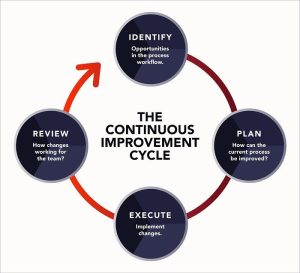
Introduction:
In today’s dynamic world of product management, the pursuit of success goes beyond delivering a product—it involves a commitment to continuous improvement. This article explores how product managers can leverage agile methodologies, particularly Scrum, strategic iteration, data-driven decision-making, and the right tools to drive excellence and innovation in their product development cycles.
1. Agile Methodologies: A Catalyst for Iterative Excellence
At the core of continuous improvement in product management lies the adoption of agile methodologies, with Scrum emerging as a powerful framework. Unlike traditional project management approaches, Agile promotes flexibility and adaptability. By breaking down projects into manageable sprints, teams can consistently deliver incremental value to customers. This iterative approach not only enhances product quality but also facilitates the integration of valuable feedback at every step. Scrum’s emphasis on collaboration and transparency ensures that teams remain agile, responsive, and aligned with evolving business goals.
Agile methodologies advocate for frequent reassessment and adaptation, allowing teams to respond swiftly to changing market demands. The iterative nature of Agile, and specifically Scrum, promotes a mindset of continuous improvement. Regular retrospectives at the end of each sprint create a feedback loop, enabling teams to reflect on what worked well and what can be enhanced in the next iteration. This iterative refinement process is essential for adapting to emerging customer needs and ensuring that the product remains aligned with strategic objectives.
2. Strategic Iteration: Aligning Roadmaps with Business Goals
Strategic iteration is a cornerstone of successful continuous improvement. Product managers must go beyond the development of a product and focus on creating a clear strategy aligned with business objectives. This involves a deep understanding of the target audience’s needs, market trends, and the competitive landscape. Aligning the product roadmap with overarching business goals ensures that each iteration contributes purposefully to the long-term success of the product. Strategic iteration requires a proactive approach, with product managers constantly refining their strategies based on market dynamics and emerging opportunities.
Strategic iteration involves a continuous cycle of planning, execution, and evaluation. The product roadmap serves as a guiding document that outlines the envisioned features, enhancements, and releases over time. However, this roadmap is not static; it evolves through each iteration based on user feedback, market trends, and the evolving business landscape. As product managers strategically iterate, they must keep a keen eye on customer needs and competitor actions, ensuring that the product remains not just relevant but also ahead of the curve in terms of innovation.
3. Data-Driven Decision-Making: The Catalyst for Informed Iterations
In the era of big data, leveraging insights is a game-changer for product managers committed to continuous improvement. Data-driven decision-making is pivotal to the iterative process, providing product managers with real-time insights into user behavior, preferences, and market trends. By collecting and analyzing user data, product managers gain a nuanced understanding of how their product is received and used. This data-driven approach empowers product managers to make informed decisions during each iteration, ensuring that changes and improvements are grounded in concrete evidence rather than speculation.
Data-driven decision-making involves a systematic analysis of key performance indicators (KPIs) and user metrics. Through tools like analytics platforms, product managers can track user engagement, conversion rates, and other relevant metrics. These insights not only guide decisions about the current iteration but also contribute to the refinement of the overall product strategy. For example, if data reveals a particular feature’s popularity or identifies user pain points, product managers can prioritize these aspects in subsequent iterations, ensuring a customer-centric approach to continuous improvement.
4. Tools: Enablers of Seamless Iteration and Collaboration
No strategy for continuous improvement is complete without the right tools. These tools serve as enablers, facilitating seamless iteration and collaboration among team members. Whether it’s project management software or analytics platforms, choosing the right tools is crucial. Project management tools help create roadmaps outlining desired outcomes and timelines for each iteration. Analytics platforms allow teams to track progress effectively and leverage data-driven insights for decision-making. The integration of these tools streamlines workflows, enhances collaboration, and ensures that everyone involved is aligned toward achieving common goals.
Project management tools are instrumental in translating strategic iteration into actionable plans. They provide a centralized platform for creating and managing roadmaps, assigning tasks, and tracking progress. This visibility ensures that all team members are on the same page regarding project timelines and goals. Collaboration tools further enhance communication, enabling team members to share feedback, insights, and updates in real-time. These collaborative platforms contribute to the iterative process by fostering an environment where continuous improvement is not only encouraged but seamlessly integrated into the workflow.
Conclusion:
In conclusion, the pursuit of continuous improvement in product management requires a multifaceted approach. By embracing agile methodologies, strategically iterating to align roadmaps with business goals, making data-driven decisions, and employing the right tools, product managers can navigate the complexities of the ever-evolving business landscape. This dynamic and iterative approach positions product managers not merely as guardians of products but as architects of sustained success in today’s competitive market. As the product management landscape continues to evolve, those who embrace continuous improvement will find themselves at the forefront of innovation and excellence.